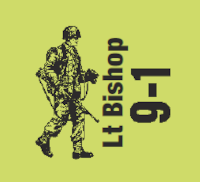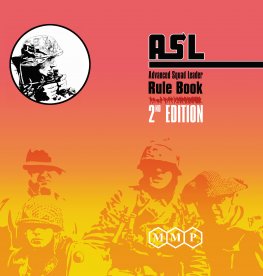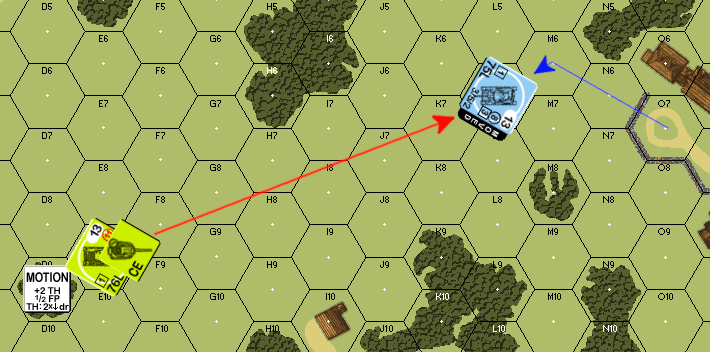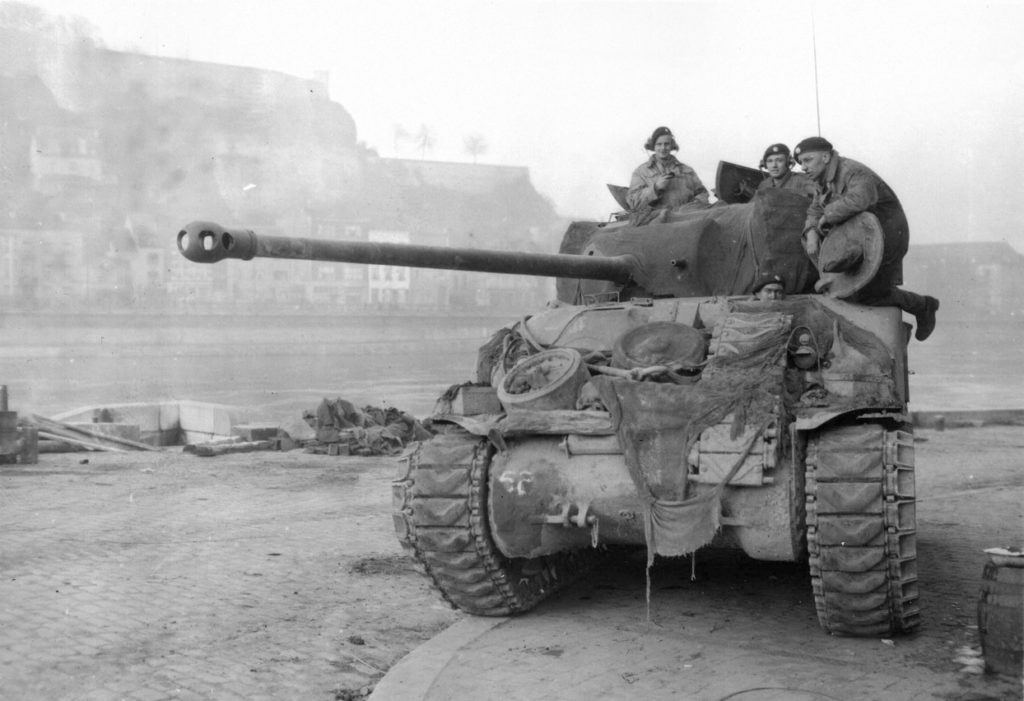
A fellow player asked a question on Discord regarding Motion Fire and Critical Hits. Specifically, he asked if an Original 1,1 is a Critical Hit when using Vehicular Target Type. Before we dive into this together, take a moment to see what you think. Got it? Good!
I have written a whole series of articles on tank vs. tank combat. I have even covered some aspects of Motion firing before. There are plenty of nuggets in those but those articles do not mention this topic. I am not sure why that is as I know that while I was writing those articles Klas and I specifically spoke about this situation. I am not sure why this didn’t make it into any articles. Let’s look together.
Rules Dive

A couple of rules come into play in this situation. First, we must consider D2.42. Per D2.42, a Motion/Non-stopped vehicle must add the case C4 To Hit (TH) DRM. Looking at the C5 Firer Based Hit Determination DRM table, Case C4 comprises one of the other C-cases (C, C1, C2, C3), with the addition of a +1 DRM for Stabilized Guns (D11.1x) or a doubling of the lower die of the Original TH DR for non-Stabilized Guns. Looking at the C Cases, Cases C1 and C2 say Case C plus an additional DRM. Case C itself says Case B plus a DRM dependent on the Gun mounting. This is a lot of cascading rules to unpack to play to even resolve the hit correctly.
Then a 1,1 is rolled. Now what?
Now the second rule comes into play. According to C3.7, a Critical Hit (CH) occurs on an Original 2 DR when firing on the Vehicle Target Type (VTT). But there is an exception, and it is important here. The exception says “If only the lowest Final TH DR possible for that shot would achieve a hit, a CH occurs only on a subsequent dr of 1 following that hit; 2-6 results in a normal hull hit (or a normal turret hit vs a HD vehicle);”.
Now that we have all the tools we need, let’s see how to properly apply them.
Example

It is the German MPh. The German player pushes a PzIV out to attack the Motion Sherman. The American player shoots at a range of 7 hexes, yielding a Basic TH# of 9. There are no modifiers so the Basic TH# is the Modified TH#.
The Motion Sherman pays the C4 TH DRM. The PzIV began in the Sherman’s LOS (or has spent at least 3 MP) so the Sherman pays Case C. The Sherman’s Gun is non-Stabilized but it has a Fast Turret Traverse (D1.31). The Sherman’s Firer-based DRM are +2 Case C, +2 Case B and it must double the lower dr of the TH DR. Since the PzIV is a Moving Vehicular Target (C.8), a +2 Case J Target-based DRM applies.

The Sherman rolls a 1,1 Original TH DR. Recall, there are +6 total DRM AND the Sherman must double the lower die of the Original TH DR. This means, the Final TH DR is a 9, exactly what the Sherman needs to hit. This means the Sherman could only hit on the lowest possible DR. While it may seem a 1,1 is a CH, the exception says we need a subsequent dr to determine the outcome. On a 1, the hit is a CH. All other drs result in a normal Hull hit, except we hit a Hull Down target in the turret on a 2 – 6, even though the hit itself is not a CH.
If the PzIV were at range 6, the Basic TH Number would be 10. All DRM remain the same. A 1,1 still yields the same Final 9 TH DR. This time, the lowest possible DR is not the only one that hits. A 2,1 or a 1,2 also hit (double the “1” to a “2”, add the +6 DRM to achieve a Final TH DR of 10). At this range, a 1,1 IS a CH.
Stabilized Gun
Refer to the previous example. Here, give the Sherman a Stabilized Gun. The Sherman’s Firer-based DRM are now Case C +1. So the total Firer Based DRM are +4 (+1 Case C4, +1 Case C, +2 Case B). The Target-based DRM remain +2. A 1,1 is now a CH (see if you can work this out).
What if the Sherman had an Acquisition? Per C6.55, a Stabilized Gun can maintain Acquisition for Motion/Bounding-First Fire TH attempts if the target remains in LOS. If it had an Acquisition, this would change the total Target-based DRM to +1. A 1,1 WOULD be a CH even at ranges 13 to 18. (Again, see if you can work this out).
If the Gun were not Stabilized, the same outcome could apply if the target is a large target.
Conclusion

If you take nothing else away from this article, remember a 1,1 is not a CH using VTT if it is the only DR that hits. This even applies if we double one of the die. You should also remember this nugget is in C3.7. Those two things together are enough to play this correctly. It will take a bit to unpack the rules, but you can get there from C3.7.
Until next time. – jim
ver 1.1


Hey! I don’t believe it – I was playing this one right!
I was going to ask about the possibility of a Multiple Hit by the Sherman in the event of a successful non-CH hit, but I see you cleverly avoided that by using a Sherman with the 76L rather than the 75.
I didn’t set out to avoid it. I just use the 76L because it is my favorite AFV in ASL.
WRT your question, I refer you to “C3.8 MULTIPLE HITS: A Gun of ≥ 15mm but ≤ 40mm that scores a non-CH hit while rolling an Original Doubles TH DR on the Vehicle/Infantry Target Type has achieved two hits instead of one …”
So if you roll a 1,1 and it is “just a hit” then it can be multiple hits. If it is a CH, it cannot be multiple hits.
Thanks for commenting!
Great Post Jim!!
Hi Jim:
Thanks for your continued excellence in articles.
I have a question about Stabilized Gun
>>So the total Firer Based DRM are +5 (+1 Case C4, +2 Case C, +2 Case B).
I look at the charts and see
Total Firer Based DRM are +4 (+1 Case C4, +1 Case C, +2 Case B).
Can you help me see why C is +2 and not +1?
[C. Bounding Firer (C5.3). Case B plus [Stabilized Gun: +1]
Thanks!
As soon as I began to read your response, I remember the Case C DRM for a Stabilized Gun is only +1. I have re-worked the examples slightly to account for the error. I have also labeled this a new revision. Thanks for catching this. — jim
Nicely done!
At seven hex range, with a non-stabilised gun, even a 1,1 isn’t a hit given total DRM of +8. I think that C3.6 (improbable hits) applies here as opposed to C3.7. A subsequent dr of 1 yields a critical hit and a dr of 2/3 yields a turret/hull hit respectively.
Can you call out your DRM? I may have missed something. I make the DRM +6 (Case B, Case C, Case J, Double the lower dr).
It is +6 for firer based DRM but there is an additional +2 (Case J) DRM for the moving target. This makes it impossible (barring an armor leader assisting with a negative modifier) to hit the target at 7 hex range without applying C3.6. At six hex range, C3.7 would definitely apply.
It’s +4 for Fire-Based DRM [Case B and C] (plus doubling of the lower die), and +2 for Target-Based DRM [Case J].
Can you explain how you get to +6 Firer-based DRM? I see +2 Case B, +2 Case C. I do not see more than that. We agree on the Target-based DRM.
If you are doubling the lower die, you are adding a minimum of +2 to the total. Obviously if you don’t roll a 1, the DRM will be higher. I only use +6 on the basis that you are talking about rolling 1,1.
The doubling of the lower die roll adds a minimum of +1 – not a +2.
Hence with a Basic TH# of 9, and Firer-Based DRM of +4 and Target-Based DRM of +2, a DR of 1,1 = 2 + 6 +1 (doubling of one of the lower die) = 9.
So a 1,1 is a hit.
I have been playing this wrong for years. It is clear enough from the text of the rules now that I re-read it but the “+ lower dr x2)” on the Firer Based DRM Table has thrown me off completely. I have always played this to mean that you double whatever the lower dr might be and then add it to the total. Ah, well- we live and learn even after thirty-five years!